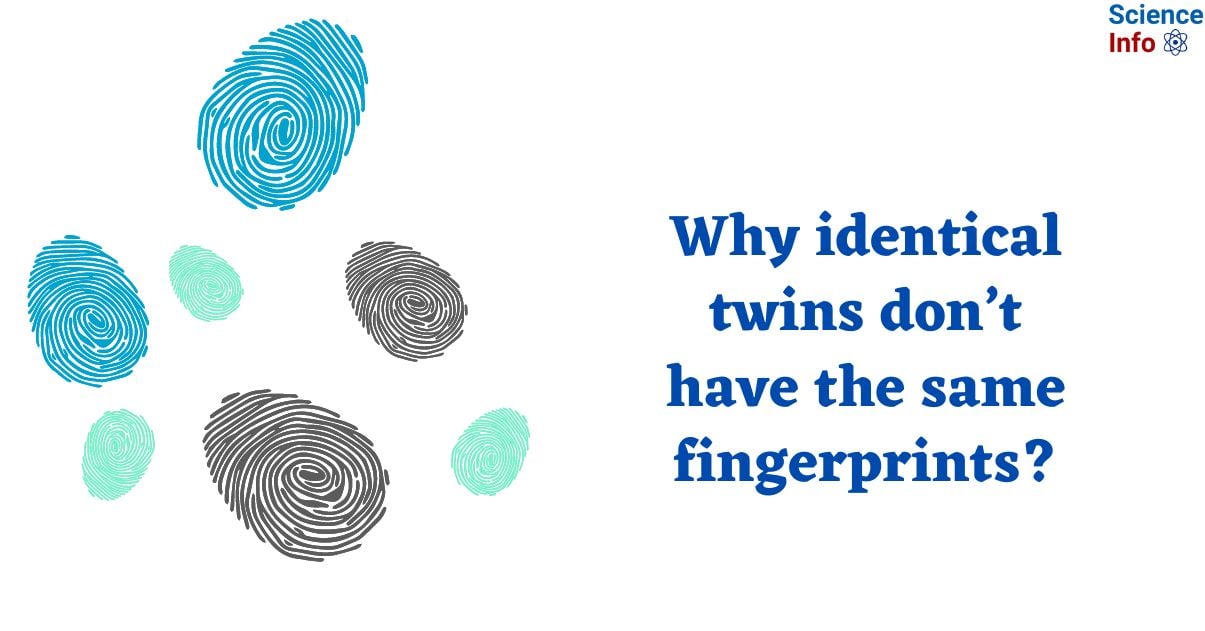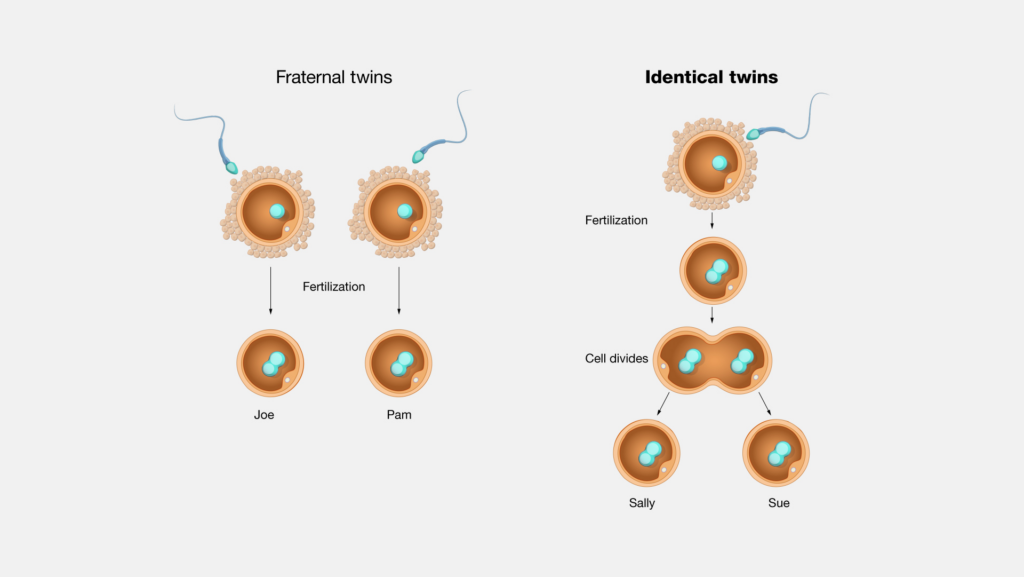Identical twins, also known as monozygotic twins, are formed when a single egg is fertilized by a single sperm, and the fertilized egg splits into two. Identical twins have same genomes and are almost always of the same sex. Identical twins have identical DNA but differing fingerprints; isn’t that interesting? But Why identical twins don’t have the same fingerprints? Let us discuss this topic.

Identical Twins
Identical twin is technically referred to as monozygotic. Monozygotic twins develop from a single fertilized egg (zygote). Following conception, the zygote divides into two halves, resulting in the formation of two separate embryos. Because the two embryos are the outcome of a single egg/sperm pairing, they share the same genetic background and thus DNA.

The reasons of monozygotic twinning are mostly unknown. Nobody really understands why eggs split. Technically, it is a problem with the regular development process. There is no inherited feature that increases the likelihood of having identical twins. Identical twins do not run in families. Although some families have a high incidence of identical twins, this is just by chance or coincidence.
Despite sharing a gene set, identical twins are distinct individuals. Each person is unique. They are influenced by minor changes in the environment in the womb as well as other factors after birth.
Why identical twins don’t have the same fingerprints?
No two fingerprints are exactly alike. That is why they are so useful for law enforcement and smartphones in accurately recognizing persons. Identical twins develop unique fingerprints on each finger, just as the rest of us do. Although it is not impossible for two fingerprints to match, the odds are extremely against it, at 1 in 64 billion.
Fingerprints form when the flesh loses some of its fluid, forcing the skin to contract or “shrivel” into the unique shape of a fingerprint. This is essentially a random process that occurs in the womb, much like the production of birthmarks, and is not genetically determined. Unlike hereditary diarrhea, fingerprints are not genetically determined.
Fingerprints are a development feature. Your DNA does not determine every physical aspect of your body. If you scarred one fingertip, it would not reflect your DNA. Your fingerprints are merely the result of the natural development of blood vessels, among other things.
There is a distinction between genotype (the makeup of our genes) and phenotype (the makeup of our body). The latter involves a number of random events that influence fingerprint formation. The genetic research is full with stories of identical twins who are discordant (i.e. not the same) in certain traits, such as one with spina bifida, another with a partly random disorder, and one without. There have even been “identical” twins, meaning they share the same DNA but are of different sexes. The answer involves intricate genetic mechanisms, yet after that, it appears simple to accept alternative fingerprints.
What is a fingerprint?
The pattern of cuticle lines on the fingers and palms, known as first fingerprints, is part of our daily life. It is distinguished by roughly parallel ridges that create distinct features. The fingertips have three distinct patterns: swirl, hook, and bow.
Crochet patterns resemble cylinders and radial circles. These profiles are tied together in triplets. This trio is made up of three apical systems that converge at an angle of 120 degrees. More intricate patterns are known as accidents, but they occur infrequently. Furthermore, the model has several flaws (sometimes referred to as fine features of fingerprints), such as dislocations. These characteristics have gained a lot of attention in forensic research since they make each human fingerprint unique and irreversible in life.
Previous research has demonstrated that fingerprinting can be used to diagnose some genetic disorders and conduct ethnicity studies, however it appears that these approaches have become obsolete with the introduction of DNA.
How are fingerprints formed?
It has long been recognized that there is a link between the apical pattern and the physical structures known as palmar pads. These pads occur on the skin of the palms for around 7 weeks at the tips of the fingers (parietal pads), at the distal region of the palm between the fingers and palm. Around the tenth week, the palmar pads grow less visible and eventually disappear in the embryo.
From the 10th to the 16th week of pregnancy, significant events occur that contribute to the formation of the rib model. At 10 weeks gestation, the embryonic palmar skin is composed of a stratified epidermis over an amorphous fibrous dermis.
The basal layer is the epidermis’ innermost layer at the contact with the dermis, and it is made up of cells with an axis perpendicular to the skin’s surface. This basal layer became wavy in embryos between the tenth and thirteenth week of development. The ripples quickly become more pronounced, forming epidermis-dermis creases. These folds are known as the major ridges. They are surface-patterned at 16 weeks. Because fingerprint patterns are encoded at the dermal-epidermal interface, skin wounds do not delete them. This procedure will continue until around 19-24 weeks of pregnancy.
Primary peaks do not form at the same time on the palmar surface. For example, crest formation on the fingertips and palms occurs before crest formation on the toes and soles of the feet. Furthermore, its creation begins in a specific location in the palmar pad, in the nail groove, and along the intercostal umbilicus. Typically, the vertex area corresponds to the ring center. As a result, there will be three systems on the fingertips, beginning with the apical groove, the nail groove, and the flexural fold and gradually expanding across the fingertip.

Fingerprint Applications
- Identifying criminals: Defense Fingerprints from crime scenes or other criminal evidence have been utilized in forensic science to identify suspects or victims. Fingerprint recognition was seen as a critical mechanism in nineteenth-century police departments, replacing anthropometric measures as a more reliable technique of identifying criminals.
- Using Smart Devices: Because two fingerprints cannot be the same, smart devices have heavily relied on this fact in their design and operation. The first application is an electronic key that is identified via fingerprints. When the points on the fingerprint match the fingerprint that was first registered in the system, the door will open automatically. These applications have since been integrated into a variety of other devices, including timekeepers and fingerprint lock/unlock on phones.
- Forensic Examination: The lipids and dead cells in a fingerprint are unique to each individual, with distinct residues and metabolic activities. Therefore, it will be employed for forensic examination. A cigarette smoker’s fingerprints, for example, will contain traces of nicotine-metabolized cotinine as well as nicotine. The existence of these chemicals is due to the interaction of fingers with tobacco products.
- Record Tracking: Over the last century, fingerprints have helped governments around the world identify criminal records accurately. As a result, fingerprints are the most fundamental instruments used by police departments to identify people with a criminal history.
References
- https://www.verywellfamily.com/twins-and-fingerprints-2446684
- https://www.sciencefocus.com/the-human-body/why-do-identical-twins-have-different-fingerprints-2
- https://www.healthline.com/health/do-identical-twins-have-the-same-fingerprints
- https://www.theguardian.com/notesandqueries/query/0,5753,-7393,00.html
- https://www.science-sparks.com/do-identical-twins-have-identical-fingerprints/
- https://www.vinmec.com/en/news/health-news/the-formation-of-fingerprints-in-humans/
- https://www.news-medical.net/news/20230315/How-do-fingerprints-develop.aspx

It’s so good and helpful I just would like u may make PDFs coz I would love to share with my friends